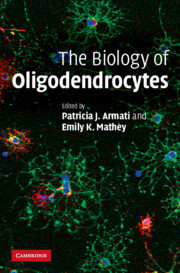Book contents
- Frontmatter
- Contents
- Preface
- Contributors
- 1 CNS oligarchs; the rise of the oligodendrocyte in a neuron-centric culture
- 2 Comparative biology of Schwann cells and oligodendrocytes
- 3 Control of oligodendrocyte development and myelination in the vertebrate CNS
- 4 Molecular organization of the oligodendrocyte and myelin
- 5 The genetics of oligodendrocytes
- 6 Immunobiology of the oligodendrocyte
- 7 Oligodendrocytes and disease: repair, remyelination and stem cells
- 8 Glial progenitor cells and the dynamics of the oligodendrocyte and its myelin in the aged and injured CNS
- 9 Oligodendroglial pathology in multiple sclerosis
- 10 Glutamate receptors, transporters and periventricular leukomalacia
- References
- Index
- Plate section
9 - Oligodendroglial pathology in multiple sclerosis
Published online by Cambridge University Press: 05 August 2012
- Frontmatter
- Contents
- Preface
- Contributors
- 1 CNS oligarchs; the rise of the oligodendrocyte in a neuron-centric culture
- 2 Comparative biology of Schwann cells and oligodendrocytes
- 3 Control of oligodendrocyte development and myelination in the vertebrate CNS
- 4 Molecular organization of the oligodendrocyte and myelin
- 5 The genetics of oligodendrocytes
- 6 Immunobiology of the oligodendrocyte
- 7 Oligodendrocytes and disease: repair, remyelination and stem cells
- 8 Glial progenitor cells and the dynamics of the oligodendrocyte and its myelin in the aged and injured CNS
- 9 Oligodendroglial pathology in multiple sclerosis
- 10 Glutamate receptors, transporters and periventricular leukomalacia
- References
- Index
- Plate section
Summary
Multiple sclerosis (MS) is the most frequent demyelinating disease of the human central nervous system (CNS) with a prevalence of 100 per 100 000 in North America and Northern Europe. The histopathological hallmarks of MS lesions are demyelination, inflammation, astrogliosis and relative axonal preservation. Oligodendrocytes and their myelin are considered to be the major targets of the disease process. Oligodendroglial damage and cell death can be observed very early and may represent an initial event in lesion formation. In MS lesions of patients with a long disease duration oligodendrocytes are almost completely absent. The mechanisms underlying the oligodendroglial cell death are not well understood and may be heterogeneous among patients. Apoptotic, necrotic and lytic cell death are implicated in the disappearance of oligodendrocytes from MS lesions. Remyelination occurs in MS lesions, but is limited in the majority of patients. Oligodendroglial precursor cells (OPCs), which have the capability to form new myelin, can be found in early MS lesions, and in reduced cell numbers also late during the disease process.
Oligodendrocytes and their progenitors have been shown to be susceptible to a broad range of inflammatory and toxic mediators in vivo and in culture. This chapter gives an overview of the current concepts regarding demyelination, oligodendroglial damage and remyelination in MS lesions.
- Type
- Chapter
- Information
- The Biology of Oligodendrocytes , pp. 171 - 185Publisher: Cambridge University PressPrint publication year: 2010
- 1
- Cited by



